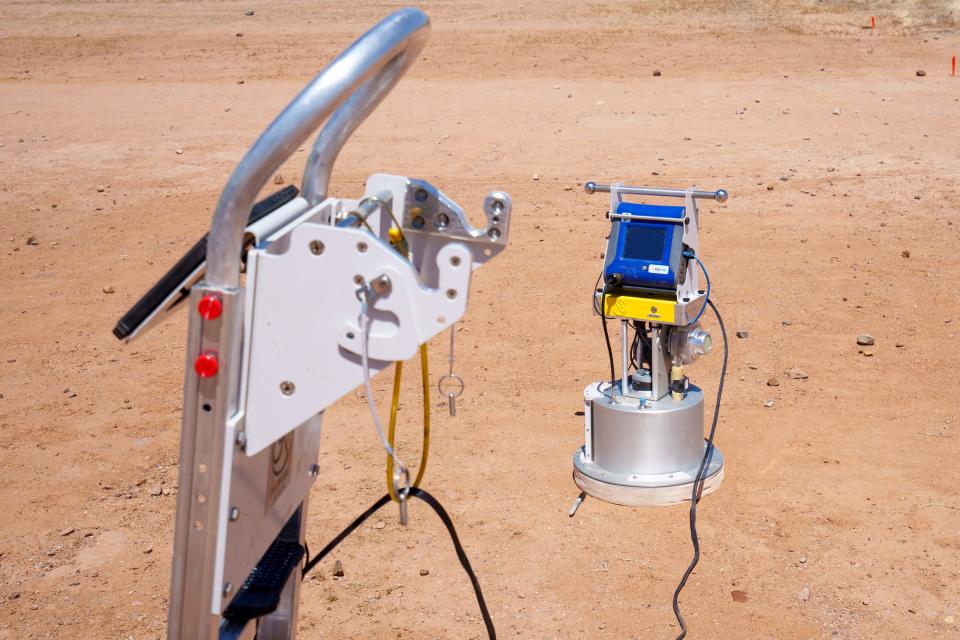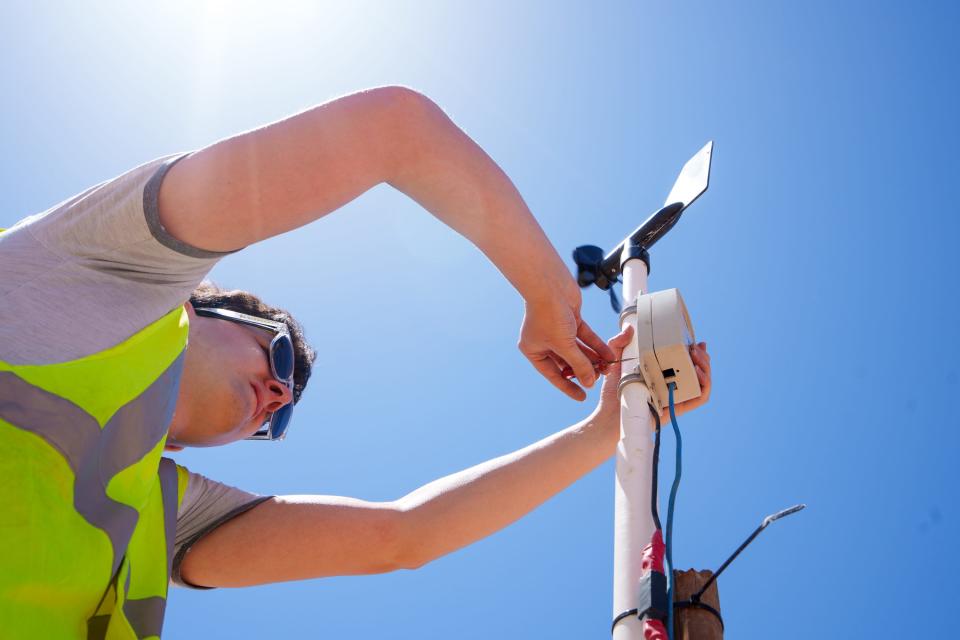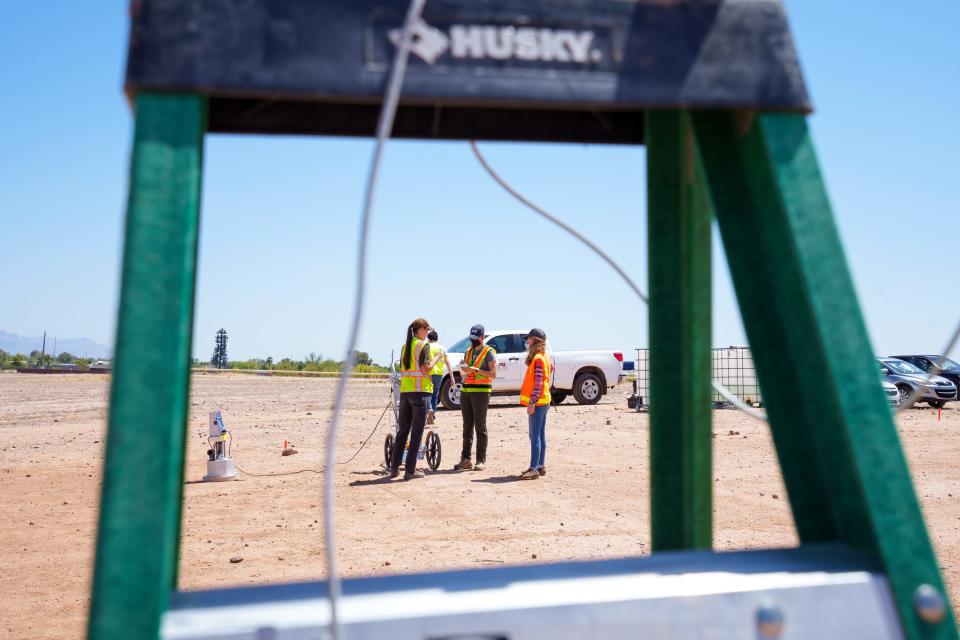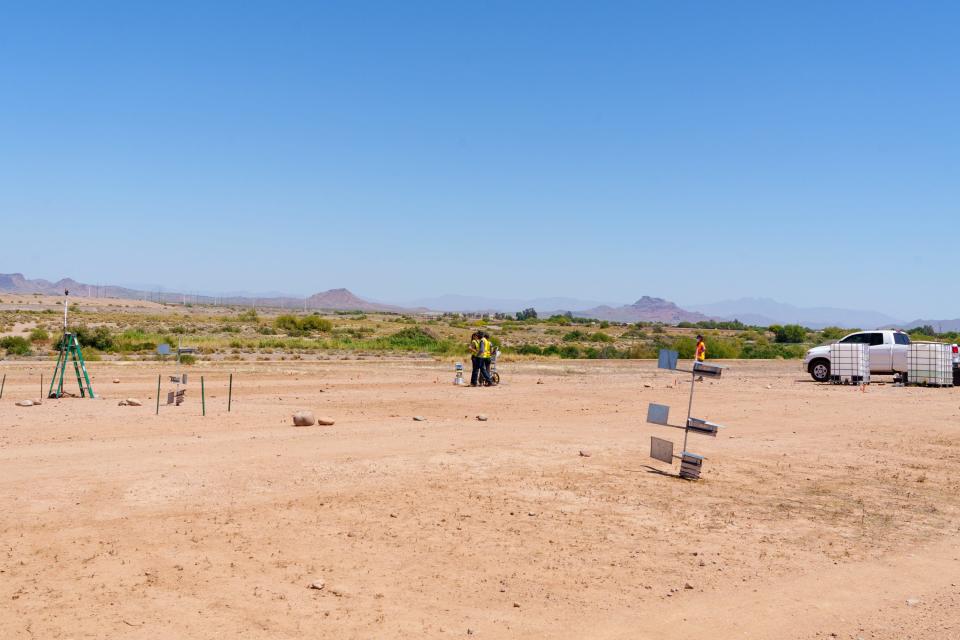'A tipping point': Arizona universities join forces to map the deadly Valley fever fungus
When 60-year-old Marana resident Julius Holt first fell ill in early March, his symptoms were vague. On March 5, the longtime youth football coach played a round of golf and attended two softball games later in the day. That's when he told his wife he was feeling under the weather.
"I was thinking it was just because he was out all day," his wife, Lisa Holt, told The Arizona Republic. "The next day was Sunday, March 6, which was actually my birthday. We went out and had breakfast and just relaxed at home ... Monday morning he said he couldn't sleep and he was going to take himself to the doctor."
Holt, a former University of Arizona football player and father of two, was admitted to the hospital that day with suspected pneumonia. He ended up staying for 10 days. Multiple COVID-19 tests came back negative. Doctors prescribed antibiotics, but they weren’t helping.
As Holt struggled to breathe, health providers suspected his illness might be caused by a potentially fatal respiratory disease that's little-known outside the American West — Valley fever.
Valley fever is a fungal infection, known by its scientific name, coccidioidomycosis. It affects both humans and dogs and in the most severe cases can cause broken bones, meningitis and death. A majority of U.S. Valley fever infections, about two-thirds of them, are contracted in Arizona — 80% of those are in Maricopa County — yet until recently, the state had made little financial investment in preventing, treating and researching the fungal infection.
That's what makes the Arizona Board of Regents' three-year, $3.3 million grant to a collaborative Valley fever research project among the three state-funded universities so historic.
The grant, which uses money from the state's Technology and Research Initiative Fund, was announced April 8. The money comes from sales tax revenue established through Proposition 301, which was extended for another 20 years in 2018. Arizona law gives the Board of Regents the responsibility to administer the fund.
"It's basically a tipping point. I mean, they've never done this before," Dr. John Galgiani, founder and director of the University of Arizona's Valley Fever Center for Excellence, said of the grant funding. “It's set into motion a conversation that this is a problem that needs to be addressed in the state of Arizona.”
Funding to map the 'Valley fever corridor'
The Valley Fever Center for Excellence dates back to 1996, and that's how long Galgiani has been advocating for more Valley fever support from the state.
The Regents' grant followed an initial state New Economy Initiative investment of $911,075 over two years, beginning in this fiscal year, to the UA to improve Valley fever disease management. The planned improvements include better doctor education, more precise diagnostics and the three-university Valley Fever Collaborative, according to Galgiani.
That initial funding was itself a major step in recognizing that the respiratory fungal disease is a serious public health and economic problem in Arizona, Galgiani said.
"The more you talk about something, the more people realize A) Something should be done about it and B) There are things we could do about it," he said.
Now, the Valley Fever Collaborative plans to use the $3.3 million Regents' grant to identify, characterize and map Valley fever hotspots.
Researchers have long pinpointed Maricopa, Pinal and Pima counties in Arizona as a so-called "Valley fever corridor," but the research funded with the Regents Grant will aim to identify specific areas within that corridor where the Valley fever-causing Coccidioides posadasii fungus grows, Galgiani explained.
The spores live in the soil but cause Valley fever when they are dislodged by construction, wind or other soil disturbances and become airborne.
"If we get good at this we can say if you are going to do construction (in a specific location) you better know (Valley fever) is going to be a risk. It could be risk abatement ... With this new information, we might prevent infections at work sites or even for everyone who lives here.”
To better understand that risk, the scientists on the team are taking a variety of approaches. Some will closely examine the soil where Coccidioides grows. Some will zoom in to the DNA of the fungus itself.
And some will try to stop dust that contains Valley fever-causing spores before it even rises into the air.

Doing donuts to stop dust
At the border of Mesa and the Salt River Pima-Maricopa Indian Community, about a quarter mile past a bent “No Trespassing” sign, sits a decommissioned landfill. And on a plot of scraped dirt in that landfill, Miriam Woolley drives a white pickup truck in circles, dragging a bit of chain-link fence behind her.
She’s on a mission to stop dust at the source.
Woolley, a graduate research associate at Arizona State University, is testing out a spray application that, if all goes well, will form a kind of protective layer over the surface of the earth and prevent dust from escaping. Matthew Fraser, a professor in the School of Sustainable Engineering and the Built Environment at ASU, says this project resembles one of the goals of the Valley Fever Collaborative: to prevent Coccidioides spores from getting into the atmosphere.
“One of the (projects) that we're going to be doing here at ASU (is) soil stabilization, which is trying to recreate the natural processes that lead to desert crust formations,” Fraser said.
One approach to creating such a crust is called “enzyme-induced carbonate precipitation," one of the methods Woolley has been testing by the Salt River. She and her team stir ingredients in barrels which, when combined, initiate a chemical reaction that will create calcium carbonate — essentially, natural cement.
"It's basically what happens over thousands of years in nature, but we do it in about 24 to 36 hours," Woolley said.
Woolley is optimistic about the spray application, especially for certain kinds of soils. But the team has to be mindful of potential health or environmental implications of the coating when dust gets kicked up. So Jason Miech, one of Fraser’s graduate students, sets up some air filters, which will help the team conduct a chemical analysis to keep an eye on the concentrations of different minerals. Those are the same kinds of air filters that Fraser will deploy in the field to look for Coccidioides spores.
On another plot, Woolley and her team have created a crust using microbes, inspired by what’s already found in nature. In the desert, natural soil crusts form when a combination of moisture and minerals build up a hard layer on the surface, or when tiny organisms coat the surface of the earth, preventing erosion.
Fraser says some of Woolley’s colleagues, other dust fighters, are “actually going out, harvesting existing desert crusts … incubating them and enriching them so that the microbes responsible for the native desert crusts grow and propagate.”
He thinks soil stabilization research will be an important end goal of the Valley Fever Collaborative and will build on the work that Woolley and her team are already doing.
Before they drive the truck onto the plot treated with chemicals, one treated with microbes and an untreated control plot, she and her team take some measurements. They use a futuristic gizmo that essentially creates a miniature wind tunnel over the surface of the crust (the device alone, Woolley says, costs about $80,000).
Then Woolley is ready to destroy her creation.
On the untreated portions of the land, dramatic “rooster tails” of dirt stream out from under her tires. But on the portions coated with the chemical and microbial sprays, a much smaller amount of dirt enters the air.
The scientists have plenty of numbers to crunch, but to the naked eye, there’s a clear difference: Woolley’s engineered crust stops a lot of the dust.
By the end of the trial, a thin layer of sediment has settled on the dashboard of the truck. Woolley, who has spent seven years developing her methods out in the sun (she described one nasty episode of dehydration), says that by now, she’s used to watching her hard work crumble in hopes of improving the science.
“I’m getting data,” she said. “I care less about destroying the crust and more about just getting a measurement.”
And Woolley and her team aren’t the only ones whose data gathering is laying the foundation for the research of the Valley Fever Collaborative.

Clues in the landscape
Every two weeks, Alexander Ederer takes a steep and slippery hike to the ridge of a hill in the Catalina Mountains. He brings his laptop with him.
Ederer, a first-year PhD student in University of Arizona professor Jon Chorover’s lab, isn’t just hiking for recreation. He’s collecting data, manually monitoring and downloading information that will help him and other scientists better understand how environmental factors like moisture and temperature shape the soil beneath his feet — and the miniature living worlds that populate it.
Ederer’s current project isn’t about fungus like the one that causes Valley fever, but detailed investigations using similar field-based methods will be necessary to better understand where Coccidioides grows and why, said Chorover, the head of the environmental science department at the UA and one of the faculty members of the Valley Fever Collaborative.
“It’s not present ubiquitously in the landscapes of the Sonoran Desert throughout Arizona. It's in unique locations, specific locations, but we don't know why it chooses those particular locations,” Chorover said. “So part of what we're trying to do is to understand what the characteristics are associated with these hotspots in the landscape.”
To do that, extensive fieldwork will be a must. Chorover says that means bringing out backhoes and shovels to dig into the earth to create what the experts call a “soil profile.” They dig a trench, sometimes deep enough for a person to stand inside, and then map the layers of soil they find. Just as researchers can classify animals and plants into different species, they can do the same with soil patterns, using color, texture and other physical characteristics as a guide.
“Soils have been called the most complex biomaterial on the planet,” said Chorover, listing the factors that shape their wide diversity, including types of rock, rain, wind and biological processes. Valley fever is just one piece of that puzzle, but Chorover wants to tackle it head-on. “If we can develop a better predictive understanding of the types of environments, the types of soils where these occur, that can really help us to mitigate the potential human exposures,” he said.
Still, he added, gathering enough data to trace a mysterious fungus across the state won’t be easy. “It will be challenging to collect a sufficient amount of data across a wide enough number of environments to be able to begin to develop powerful predictive models."
It's time-consuming and sometimes tedious, but Ederer said the fieldwork is valuable.
“Every time I go into the field, I notice something different,” he said. “It's definitely worthwhile to spend time in the field and to understand an environment in person, as well as through data collection.”

Creating a “criminal database” of fungus
Like Ederer, Bridget Barker has spent her share of time in the rugged landscapes of Arizona. And well before the coronavirus pandemic, donning an N95 face mask was second nature to her.
Barker, an associate professor of biology at Northern Arizona University, had to put her Valley fever research on hold for several months starting in 2020 so she could help with SARS-CoV-2 efforts. Her lab, designed to handle a dangerous fungus, has the same biosafety requirements that were needed to study the novel coronavirus, and she says they even donated some of the PPE they had used to protect themselves from Valley fever to frontline health care workers.
But now she’s back to studying what she calls her “pathogen of choice.” Fascinated by the ecology of the fungus and compelled by its impact on human health, Barker has been working for over a decade to try to crack the code of Valley fever.
“Once I started, I couldn’t stop,” she said of her research. “It’s just fascinating to me.”
Before the pandemic, Barker and her team collected samples about twice a year, enough to see Coccidioides growth peak in winter and early spring. But now, with this new grant, they’ll be able to examine those patterns of seasonality on a much finer scale, using samples collected every month.
And with the additional funding and partnerships, it won’t just be soil samples. The Valley Fever Collaborative will also be sampling the air at known Valley fever-positive sites to see whether air and ground hotspots match up.
The air sampling technology features a four-foot-tall box that vacuums air over a filter, leaving behind evidence that scientists can examine closely, said Fraser, of ASU. He will be working on an air filtration component of the grant that Barker and others can add to their samples.
“What we do is we put out pristine, clear filters and then they come back all soiled,” he said. “It’s that soiled material which we're actually analyzing.”
The filters separate out particles by size so research teams can hone in on only the components of dust that can get into the respiratory system. “We only capture those particles that would be inhaled into people's lungs, so that we're actually measuring what people end up exposed to,” he said.
It’s all with the goal of laying the groundwork for a systematic approach in the lab, one guided by many of the same principles as research into other disease agents, including work to track coronavirus variants.
Once the researchers have extracted the bits and pieces of Coccidioides from soil and air across the state, they want to characterize those samples using genetic material from the fungus itself, said Paul Keim, the executive director of the Pathogen and Microbiome Institute at Northern Arizona University.
“We're building the criminal database for the Valley fever fungus. And so when somebody gets it, we're going to be able to tell you where they got it based upon this database,” Keim said.
To do that, they’ll need to use methods similar to those used by scientists who examine ancient DNA. If you’ve ever heard about plans to resurrect a woolly mammoth or seen a lineage tracing back our Neanderthal ancestry, it’s the same idea. In those cases, there’s not much DNA left behind, just as there might not be much Coccidioides DNA in a shovelful of dirt brought back by a field researcher.
So in the lab, Keim says they go “fishing” for what DNA remains. DNA’s structure is double-stranded (think of the iconic double helix), so any given segment has its matching half. In the lab, Keim says they take advantage of that structure by creating “baits,” which act like molecular magnets that pull in only the matching half of whatever part of the DNA the researchers are looking for.
And DNA is highly specific, so once they build the right baits, “we’re gonna catch bass, not trout,” Keim says. In other words, with the money from the grant, they’ll perfect the recipe for singling out Valley fever DNA and telling it apart from all the other fragments of DNA in any given handful of soil.
It might sound advanced, but scientists have imagined using genetic techniques to map Valley fever since as early as the 60s or 70s. Now, Barker says, the technology and the resources might actually make it possible.
“They didn't have easily accessible PCR (testing) and ways to easily assess the fungal load in the soil, over months and months,” Barker said. “We're at the perfect time to be able to look at some of those real important fundamental questions, and actually be able to get the answers.”

Promise for patients
Initial Valley fever tests weren't conclusive for Julius Holt, the Marana youth football coach. Still, doctors prescribed him the antifungal medication fluconazole just in case it was Valley fever. He was discharged March 16.
But Holt’s breathing worsened and by March 20, he was back in the hospital. A few days later, his doctors’ suspicions were confirmed when he tested positive for Valley fever.
Lisa Holt was familiar with the disease. She’d been previously infected but only found out when a pulmonologist told her in 2016 that her lung scan indicated Valley fever.
If she’d ever had any Valley fever symptoms, they were vague and did not significantly impair her life, she said.
Through April 14 of this year, 2,642 cases of Valley fever had already been reported in Arizona. There were 11,628 cases reported in the state in 2021, 11,523 cases in 2020, and 10,358 in 2019, though Galgiani and other Valley fever experts say the number of cases reported is likely an undercount.
Sixty percent of people who inhale a Coccidioides spore have no symptoms or only very mild flu-like symptoms, do not see a doctor, and don't make it into the statistics. Others are misdiagnosed, since the symptoms of Valley fever can be mistaken for pneumonia, lung cancer and other diseases that affect the lungs, including COVID-19.
On average, there were approximately 200 Valley fever-associated deaths each year in the U.S. between 1999 and 2019, according to the Centers for Disease Control and Prevention. The most recently available state data says there were 98 Valley fever-associated deaths reported in Arizona in 2020 and 102 in 2021.
The last time the state of Arizona made any significant investment in Valley fever was in 2007, under former Gov. Janet Napolitano, when the health department's Valley fever program was allocated $300,000 in state funds. The money went into an education video, an enhanced surveillance project, and research at the UA.
The state allocation went away in 2008. With the exception of some funding between 2010 and 2012 from the Arizona Biomedical Research Centre, the Arizona Department of Health Services has since been relying mainly on federal grants for Valley fever surveillance and education.
Increased awareness and better Valley fever prevention tools could save millions of dollars in the cost of physician visits, diagnostic procedures, antifungal medications, hospitalization and lost wages, among other things, various analyses have shown.
Improvements in Valley fever awareness and disease management could also save patients and families from sickness and heartache.
Sterling Lewis, who played linebacker for the UA football team in 2008 and 2009, died in February 2020 after being hospitalized for Valley fever in Texas. He was 32.
On March 30, Lisa Holt was at her job teaching middle school when the hospital called to say her husband needed to be placed on a ventilator. By that point, his blood oxygen level would not go above 75. The normal range is typically about 95 to 100.
Holt's prior history of heart problems complicated his treatment, his wife said, and on April 4 he died. The cause of death was multi-organ failure and septic shock due to Valley fever, she said.
"We were fearful that something might happen but nothing like this," Lisa Holt said."We didn't think this was going to be it. We were trying to stay positive that one of the medicines would work and that he'd make a full recovery."
Holt played defensive tackle on the 1981 and '82 UA football teams. He worked as a counselor, in the athletic department at UA, was president of the Tucson Youth Football and Spirit Federation and volunteered coaching youth sports for more than three decades. In 2019 he was named to the American Youth Football and Cheer Hall of Fame.
"That people die from Valley fever, it's still something I don't think people are aware of," his wife said.
Reach the reporter at Stephanie.Innes@gannett.com or at 602-444-8369. Follow her on Twitter @stephanieinnes
Independent coverage of bioscience in Arizona is supported by a grant from the Flinn Foundation.
Melina Walling is a bioscience reporter who covers COVID-19, health, technology, agriculture and the environment. You can contact her via email at mwalling@gannett.com, or on Twitter @MelinaWalling.
Support local journalism. Subscribe to azcentral.com today.
This article originally appeared on Arizona Republic: Valley fever research in Arizona gets $3.3M grant from the state

